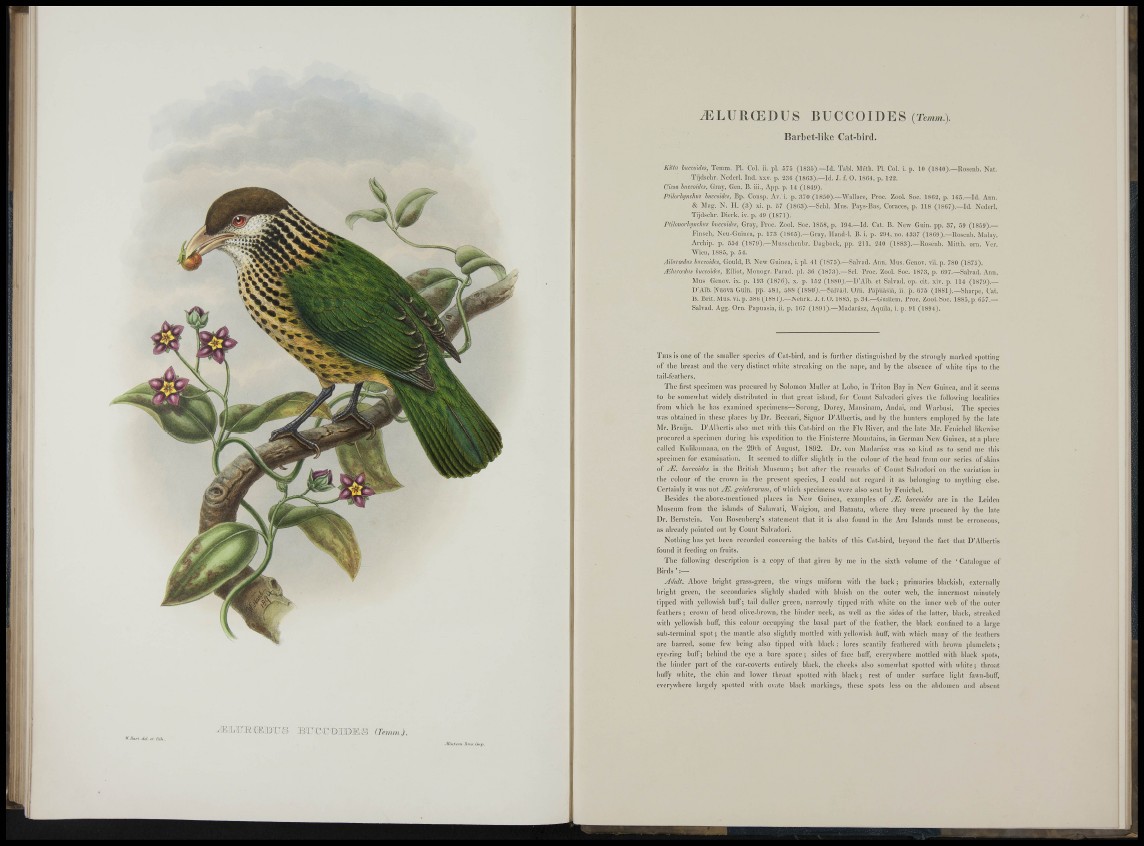
/ELURCEDUS BUCCOIDES {Tem»i.).
Baibet-like Cat-bird.
- • E L , r : R C K D T ' S :Bi[:'crDi:D:Es íTemmj.
• illn/i:in /ir^'.'-. i/ii
Kitla Imccoiiles, Temm. PI. Col. ii. pi. 575 (1835)-—Id. Tabi. Mitli. PI. Col. i. p. 10 (1840).—Roscnlì. Nat.
Tijdsclir. Nederl. Ind. xxv. p. 230 (1803).—Id. J. f. 0 . 1804, p. 122.
Cissa hiiccoides, Gray, Gen. B. ili., App. p. 14 (1849).
Pliìarhjnchiis liiccoides, Bp. Consp. Av. i. p. 37ü (1 8 5 0 ) .—Wa l l a c e , Proc. Zool. Soc. 1802, p. 105.—Id. Ann.
Se Mag. N. H. (3) xi. p. 67 (1803).—Sebi. Mns. Pays-Bas, Coraccs, p. 118 (1807).—Id. Nederl.
T i j d s c b r . Dicrk. iv. p. 49 (1871).
Plilomrhjncìms ìwccoides, Gray, Proc. Zoul. Soc. 1S5S, p. 194.—Id. Cat. B. New Guin. pp. 37, 59 (1859).—
Finseb, Neu-Guinea, p. 173 (1865).—Gray, Iland-1. B. i. p. 294, no. 4337 (180!)).—lìosenb. Malay.
Archip. p. 554 (1879).—Mussebenbr. Dagbock, pp. 211, 240 (1883).—Rosenb. Mittb. oni. Ver.
Wien, 1885, p. 54.
Ailm-osdiííí hiiccoìdcs, Gould, B. New Guinea, i. pi. 41 (187.5).—Salvad. Ann. Mus. Genov. vii. p. 780 (1875).
JEhraias luccoideg, Elliot, Monogr. Parad, pi. 3(> (1873).—Sei. Proc. Zool Soc. 1873, p. 097.—Salvad. Ann.
Mns Genov. ix. p. 193 (187fi), x. p. 152 (1880J.—D'Alb. et Salvad, op. cit. xiv. p. 114 (1879).—
D'Alb. Nuova Guin. pp. 581, 588 (1880).—Salvad. Oru. Papuasia, ii, p. 075 (1881).—Sharpe, Cat.
B. Brit. Mus. vi. p. 380 (18S1) .—Nehrk. .1. f. 0 . 1 8 8 5 , p. 34.—Gui l lem. Proc. Zool. Soc. 1885, p 057.—
Salvad. Agg. Orn. Papuasia, ii. p. 107 (1891).—Madarász, Aquila, i. p. 91 (1894).
T i n s is one of the smaller spceies of Cat-bird, inid is furtlier distiiigiiisbed by tlie strongly niurKcd spottinf;
(if tbe breast and tlie very distinct white streaking on the iia|ie, and by the abseiice of ivliite tips to tlie
t a i l - f e a t h e r s .
T h e (irst specimen was procured by Solomon Muller at Lobo, in Triton Bay in New Guinea, and It seems
t o be somewliat widely distributed iii tliat great ishiud, for Count Salvadorl gives the following localities
f r om Hhieli he has exumiued specimens—Sorong, Dorey, Mansluam, Andal, and Warhusl. The species
was olitained in these ]ilaces Iiy D r . Beccarl, Signor D'Albertls, and by the hunters employed by the late
Mr. ]5ruljn. D'Alliertis also met with this Cat-bird ou tlie Fly River, and the late Mr. Fenichel likewise
p r o c n r e d a specimen during his expedition to the Flnlsterre Mountains, in German New Guinea, at a ]ilace
called Kulikuniaiui, on the 29lh of August, 1892. Dr. von Madara.sz was so kind as to send me this
s]iecimen for examlMation. It seemed to diller slightly in the colour of the head from our series of skins
of / E . buccoides In the British Museum ; but after the remarks of Count Salvador! on the variation in
t h e colour of the crown in the present species, 1 could not regard It as belonging to anything else.
C e r t a i n l y it was not /E. geislcrorum, of which specimens were also ser.t by Fenichel.
B e s i d e s the above-mentioTied ])laces In New Guinea, examples of /E. huccoules are in the Leiden
M u s e u m from the Islands of Salanatl, Waigiou, and Batanta, where they were ]irocured by the late
D r . Bernstein. Vou liosenberg's statement that it is also found in the Aru Islands must he erroneous,
a s already pointed out by Count Salvador!.
N o t h i n g has yet been recorded concerning the habits of this Cat-bird, beyond the fact that D'Albertls
f o u n d It feeding on fruits.
T h e following description is a copy of that given by me in the sixth volume of the ' Catalogue of
B i r d s •
Aihilt. Above bright grass-green, the wings uniform with the back; primaries blackish, externally
b r i g h t green, the secondaries slightly shaded with bluish on the outer web, the innermost minutely
t i p p e d with yellowish buff; tall duller green, narrowly tljiped with white on the inner web of the outer
f e a t h e r s ; crown of head olive-brown, the hinder neck, as well as the sides of the latter, black, streaked
with yellowish buff, this colour occupying the basal part of the feather, tbe black confined to a large
s u b - t e r m u u i l spot; the mantle also slightly mottled with yellowish buff, with which many of the ieathers
a r e barred, some few being also tip])ed with black; lores scantily feathered wltli brown plumelets;
e y e - r i n g buff; behind the eye a bare s]>acc ; sides of face buff, everywhere mottled with black spots,
t h e hinder part of the ear-coverts entirely black, the cheeks also somewhat spotted with white; throat
bidfy white, the chlu and lower throat spotted with black; rest of under surface light fawn-buff,
e v e r y w h e r e largely spotted with ovate black markings, these spots less on the abdomen and absent